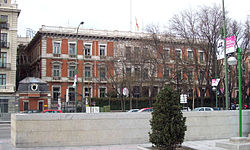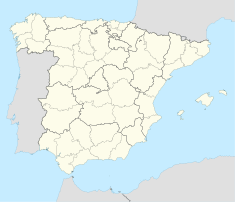
The Retiro Park, also known as Buen Retiro Park or simply El Retiro, is one of the largest city parks in Madrid, Spain. The park belonged to the Spanish monarchy until 1868, when it became a public park following the Glorious Revolution.
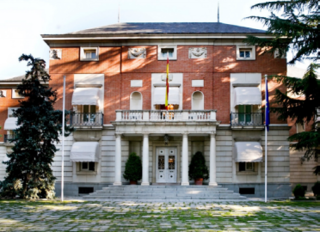
The Palace of Moncloa or Moncloa Palace is the official residence and workplace of the President of the Government, a position usually known in the English language as the Prime Minister of Spain. It is located in Puerta de Hierro Avenue, in the Moncloa-Aravaca district in Madrid. It has been the official residence of the Prime Minister since 1977, when Adolfo Suárez moved the residence from the Palace of Villamejor.

The Paseo del Prado is one of the main boulevards in Madrid, Spain. It runs north–south between the Plaza de Cibeles and the Plaza del Emperador Carlos V, with the Plaza de Cánovas del Castillo lying approximately in the middle. The Paseo del Prado forms the southern end of the city's central axis. It enjoys the status of Bien de Interés Cultural (BIC), and as part of a combined UNESCO World Heritage Site with Buen Retiro Park.

Paseo de Recoletos is a wide boulevard in central Madrid leading from Plaza de Cibeles to Plaza de Colón.

Paseo de la Castellana, commonly known as La Castellana, is a major thoroughfare in Madrid, Spain. Cutting across the city from south to north, it has been described as the "true structuring axis" of the city.

The Palacio Duhau - Park Hyatt Buenos Aires is a five star hotel located in the city's Recoleta section. Originally opened in 1934, the palace has been operated by multinational hospitality company Hyatt since 2006. The palace was declared national historic landmark in 2002.
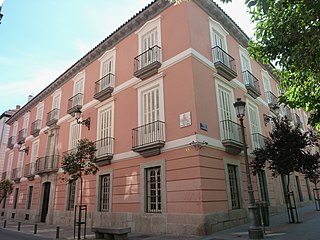
The Palace of the Marquis of Molins is a nineteenth-century building in Madrid, Spain. Originally the property of Mariano Roca de Togores y Carrasco, 1st Marquis of Molíns, it now belongs to the state. It was adapted in the 1970s to serve as an annex to the Real Academia de la Historia. The building is protected by a heritage listing, having been declared Bien de Interés Cultural in 2004.

The Palace of Linares is a palace located in Madrid, Spain. It was declared national historic-artistic monument in 1976. Located at the plaza de Cibeles. It is the seat of the Casa de América.

The Palace of Marqués de Grimaldi is a palace located in Madrid, Spain. It was declared Bien de Interés Cultural in 2000.
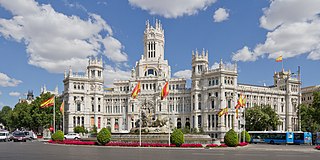
Cibeles Palace, formally known as Palacio de Comunicaciones and Palacio de Telecomunicaciones until 2011, is a complex composed of two buildings with white facades and is located in one of the historical centres of Madrid, Spain. Formerly the city's main post office and telegraph and telephone headquarters, it is now occupied by City Council of Madrid, serving as the city hall, and the public cultural centre CentroCentro.
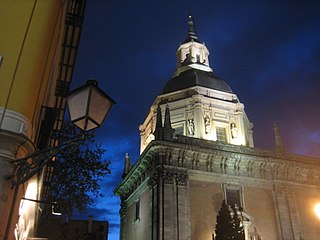
The Church of San Andrés is a church in Madrid, Spain. It was declared a Bien de Interés Cultural in 1995.
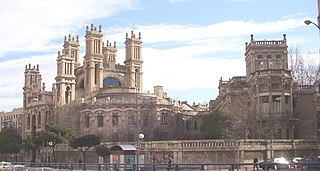
The Hospital of Maudes is a former hospital located in Madrid, Spain. It is a complex of buildings including a church. The buildings are linked apart from accommodation for infectious diseases.

The Beti Jai fronton is a sport venue located in Madrid, Spain.

The Palacio de Xifré is a Madrilenian palace now disappeared that was in the Paseo del Prado, at the corner Calle de Lope de Vega, opposite the Prado Museum. It was one of the best examples of Neo-Mudéjar architecture in Madrid and one of the palaces that the Spanish financial elite of the second half of the 19th century had built along the paseos del Prado, Recoletos and la Castellana.

The Hipódromo de la Zarzuela is a race course on the outskirts of Madrid, Spain. It was designed in the 1930s. The architecture is in a modernist style which has been described as racionalismo madrileño.

The Bank of Spain Building is the main headquarters of the Bank of Spain. Located in Madrid, it lies at the crossing of the Calle de Alcalá and the Paseo del Prado.

The Palacio de la Prensa is a brick-clad building in Madrid, Spain.

The Palacio de Congresos de Madrid, also known as Palacio de Congresos or Palacio de Congresos y Exposiciones, is a convention centre in Madrid, Spain. Located in the Paseo de la Castellana, it is unused since 2012. The building's façade prominently displays a ceramic mosaic reproducing a work by Joan Miró.

The Calle de Génova is a street in Madrid, Spain. It is the dividing line between the neighbourhoods of Justicia and Almagro, in the respective districts of Centro and Chamberí. It runs from the Plaza de Alonso Martínez to the Plaza de Colón.
